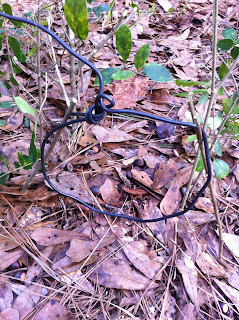Practicing situational awareness … being observant … is something that I am given to. It’s not an
occasional thing. It’s a lifestyle thing. It’s an at-all-times thing where the subjects being observed vary depending
upon the environment I happen to be in
at any given moment.
There are things that I want to know so I am always looking … always employing my
senses of sight, smell, and hearing.
I want to always know
…
What is around me,
Over me,
Beneath my feet,
Subjects that can
help sustain me if needed,
Subjects that pose a potential
physical threat to limb or life.
I consider this business of practicing situational awareness
to be an essential part of any reliable skills
set toolbox. Not only in protecting one’s self from physical harm from an
assortment of subjects but also in being able to identify and utilize surrounding
resources.
Turning Trash to Tool
People leave things behind when they leave the woods. Some
people see the woods as a place to haul their trash to dispose of it. It is
both a sad reality and a scrounger’s dream in the same breath. One man’s trash
can definitely become another man’s treasure … provided there are tools and
skills ready at hand.
A Simple Unbaited Peg Trail Set
This is an unbaited set. The key for its success in catching is locating a well used small game trail.
Tip - Always carry something in your kit that will cut wire. Never use your knife for this purpose. Your blade will be dulled so badly that its usefulness as a cutting tool for whittling, skinning, and slicing will be greatly diminished. Shirli and I both have quality multi-tools in our main kits. I carry the needle nose side cutters in my day pack.
The trigger utilizes two simple 7 Notches. One facing up. One facing down. I always cut a groove in the top piece to eliminate the possibility for the snare (under tension) to slip off the peg.
It can be a trick to locate a suitable sapling along the game trail. I look for something about an inch in diameter at the upper end. The purpose of the sapling is to keep tension on the snare once an animal is caught in it.
I cut a notch in the sapling to eliminate the possibility of the snare material from slipping on the sapling.
A spring pole can be improvised by lashing a suitable sized sapling to a nearby tree or by utilizing a low hanging overhead tree limb.
The snare in place and supported.
The wire is stiff enough to hold its shape well and only needs supporting. For rabbit sized animals the snare works well if set a couple inches off the ground.
Use trimmings from the sapling on both sides of the snare to create a funnel and conceal the snare.
This unbaited set can be modified to accommodate large animals. Large animals require stronger snare components. Also, with large animals, realize the risks being taken once a large animal has been ensnared. Leave large animals alone unless you have the proper tools to dispatch them. Getting close enough to put one down with your knife is putting yourself in harms way.
Keep this in mind too.
If the trigger slips on a small snare set ... and the little sapling slaps you on the face ... it's going to sting a little. A 3 inch tree used for a large animal can break your jaw. A hit to your temple can leave you laying there as an easy meal for the buzzards, possums, and hogs.
Practice situational awareness.
Practice skills.
Be safe.





No comments:
Post a Comment